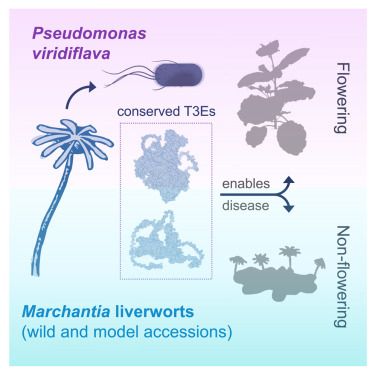

Very happy to share the published version of our work on natural Marchantia-Pseudomonas interactions.
Out now in Current Biology: www.cell.com/current-biol...

Read in @newphyt.bsky.social
doi.org/10.1111/nph....
@dromius.bsky.social


Spatial & temporal tracking of the Nicotiana root symbiosis with arbuscular mycorrhiza fungi using MycoRed.
Videos, images & optimised Rhizotrons by Nicolas Garcia Hernandez @slcuplants.bsky.social
Science behind it: journals.plos.org/plosbiology/...
Spatial & temporal tracking of the Nicotiana root symbiosis with arbuscular mycorrhiza fungi using MycoRed.
Videos, images & optimised Rhizotrons by Nicolas Garcia Hernandez @slcuplants.bsky.social
Science behind it: journals.plos.org/plosbiology/...
@cp-trendsmicrobiol.bsky.social Spotlight from @dromius.bsky.social on @cp-cellhostmicrobe.bsky.social paper from Zhong Wei/Xingang Zhou with @mrillig.bsky.social @mvanderheijden.bsky.social
www.cell.com/trends/micro...

@cp-trendsmicrobiol.bsky.social Spotlight from @dromius.bsky.social on @cp-cellhostmicrobe.bsky.social paper from Zhong Wei/Xingang Zhou with @mrillig.bsky.social @mvanderheijden.bsky.social
www.cell.com/trends/micro...
More about Victor here: www.oeaw.ac.at/gmi/detail/n...

#PlantaePSRW

#PlantaePSRW
This prestigious 4-year #PhD programme trains graduate students in Plant and Microbial Sciences at the JIC, @thesainsburylab.bsky.social and @earlhaminst.bsky.social.
🗓️ Closing date - 13 November 2025
www.jic.ac.uk/training-car...

This prestigious 4-year #PhD programme trains graduate students in Plant and Microbial Sciences at the JIC, @thesainsburylab.bsky.social and @earlhaminst.bsky.social.
🗓️ Closing date - 13 November 2025
www.jic.ac.uk/training-car...
It was a team effort! So thank you, Patrick Hickland, Alison Smith, and the rest of the Plant Met lab at the Department of Plant Sciences, University of Cambridge.

It was a team effort! So thank you, Patrick Hickland, Alison Smith, and the rest of the Plant Met lab at the Department of Plant Sciences, University of Cambridge.
doi.org/10.1101/2025...

And thanks to all collaborators Henk-jan @brunongou.bsky.social @jonathandgjones.bsky.social
And thanks to all collaborators Henk-jan @brunongou.bsky.social @jonathandgjones.bsky.social
www.cell.com/cell-reports...

📖 nph.onlinelibrary.wiley.com/doi/10.1111/...
#PlantScience

📖 nph.onlinelibrary.wiley.com/doi/10.1111/...
#PlantScience
www.findaphd.com/phds/project...
www.findaphd.com/phds/project...
Lab website: sites.google.com/site/danielg...

Lab website: sites.google.com/site/danielg...
The manuscript is @emma-raven.bsky.social's PhD work showing that whether a leaf is a carbon sink or a carbon source influences how they execute immune responses.
Have a read!
#PlantScience
@johninnescentre.bsky.social
The manuscript is @emma-raven.bsky.social's PhD work showing that whether a leaf is a carbon sink or a carbon source influences how they execute immune responses.
Have a read!
#PlantScience
@johninnescentre.bsky.social
🌿🌿Our article on fern immunity has been peer-reviewed 🌿🌿
Thanks to @madeleinebaker.bsky.social @kellerjeanphd.bsky.social @maximebonhomme.bsky.social @pierremarcdelaux.bsky.social and @jacquet-chris.bsky.social
a quick thread 🧵 1/4

🌿🌿Our article on fern immunity has been peer-reviewed 🌿🌿
Thanks to @madeleinebaker.bsky.social @kellerjeanphd.bsky.social @maximebonhomme.bsky.social @pierremarcdelaux.bsky.social and @jacquet-chris.bsky.social
a quick thread 🧵 1/4
Start date: October 2026. For more information and how to apply👉 biodtp.norwichresearchpark.ac.uk/projects/bey...

Start date: October 2026. For more information and how to apply👉 biodtp.norwichresearchpark.ac.uk/projects/bey...

Come help us understand the wheat rhizosphere at the Earlham Institute 🦠
Working at the interface of fungal antagonists & pathogens (@rowenahill.bsky.social @neilhall.bsky.social ), host genetic diversity (Simon Griffiths -JIC) and bacterial community diversity (Jacob Malone -JIC)

Come help us understand the wheat rhizosphere at the Earlham Institute 🦠
Working at the interface of fungal antagonists & pathogens (@rowenahill.bsky.social @neilhall.bsky.social ), host genetic diversity (Simon Griffiths -JIC) and bacterial community diversity (Jacob Malone -JIC)
How do cells communicate when it's hot?
Don't know? Me either! Come work with us @johninnescentre.bsky.social and figure it out
biodtp.norwichresearchpark.ac.uk/projects/how...

How do cells communicate when it's hot?
Don't know? Me either! Come work with us @johninnescentre.bsky.social and figure it out
biodtp.norwichresearchpark.ac.uk/projects/how...
biodtp.norwichresearchpark.ac.uk/projects/van...

biodtp.norwichresearchpark.ac.uk/projects/van...


